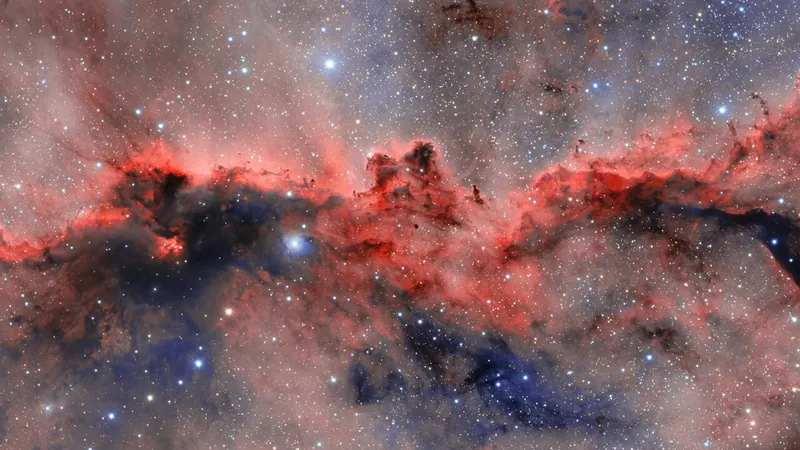
Unveiling the Secrets of Snowball Earth: Astonishing Discoveries from Colorado's Pikes Peak
2024-11-12
Author: Emily
Introduction
Around 700 million years ago, our planet experienced one of the most severe climate crises in its history: a phenomenon now known as Snowball Earth. During this period, Earth plunged into a deep freeze, with massive ice sheets encasing the globe, leading to dramatic impacts on our planet's climate and geology. However, against all odds, life not only persisted under the thick ice but thrived, ultimately paving the way for the emergence of multicellular organisms that would eventually evolve into the rich tapestry of life we recognize today.
Events surrounding Snowball Earth have largely been inferred from sedimentary rocks found in coastal and shallow-sea regions, coupled with sophisticated climate modeling. Yet, until very recently, physical evidence indicating that ice sheets extended into the interior of continents—particularly in warm equatorial zones—has eluded scientists.
In groundbreaking research recently published in the Proceedings of the National Academy of Sciences, geologists have unveiled a critical piece of evidence from surprising sandstone formations embedded within the granite of Colorado's iconic Pikes Peak.
Pikes Peak: A Geological Mystery Revealed
The rocks on Pikes Peak, referred to as Tava by the Ute peoples, are characterized by unique solidified sand deposits known as injectites. These intriguing rock formations formed when high-pressure sand-laden fluids were forcefully injected into underlying rocks, resembling modern medical injections.
The theory behind the creation of these sandstones suggests that the immense pressure from a Snowball Earth ice sheet may have compelled sediment, mixed with meltwater, deep into the more fragile bedrock below. However, a major challenge to this hypothesis had been the uncertainty surrounding the age of these rocks, preventing a clear understanding of when the necessary geological conditions for sand injection occurred.
Recent advancements in laser-based radiometric dating techniques have allowed researchers to measure uranium-to-lead ratios within iron minerals situated alongside these sandstones. The findings revealed that the injectites formed between 690 million and 660 million years ago. This time frame corresponds with the Cryogenian Period, a time of extreme global cooling synonymous with climate upheaval and ecological disruption linked to Snowball Earth.
The Cryogenian Connection and Its Implications
The Cryogenian Period, ancient Greek for "cold birth," was marked by severe climatic shifts, though the exact triggers are still hotly debated. Some leading theories propose that tectonic shifts released particles into the atmosphere, reflecting sunlight away from Earth, while volcanic activity gradually increased carbon dioxide levels, contributing to warming after the ice melted.
The Tava injectites offer vital new insights into this ancient climate. Formed near what used to be the equator on a supercontinent called Laurentia, these formations tell a story of geological evolution that stretches back through time as the land mass ultimately migrated northwards.
For over a century, geologists have speculated about the origins of Tava rocks. This latest research harnesses cutting-edge technology, linking these rocks definitively to the Snowball Earth epoch for the first time.
Earth's Geological Puzzle: Beyond Snowball Earth
Interestingly, these new findings not only bolster the Snowball Earth hypothesis but also shed light on other significant geological mysteries, including the phenomenon of unconformities—gaps in the rock stratigraphy that can be observed in renowned locations such as the Grand Canyon. These unconformities can occur when long periods of erosion strip away layers of rock, creating missing time in the geological record.
The research suggests that a prominent unconformity in the Pikes Peak region predates the Cryogenian period, contradicting past theories that attributed its formation to massive erosion caused by the icy grip of Snowball Earth.
As scientists continue to untangle these ancient geological tales, the secrets hidden within Colorado's Cryogenian rocks could unlock further terrestrial records of Snowball Earth. Discovering more about this tumultuous period will enhance our understanding of Earth’s history during extreme climate phases and contribute to our knowledge of how life finds a way to adapt and evolve on our ever-changing planet.
Is the story of Snowball Earth just the tip of the iceberg? As research continues, the implications for earth sciences could transform how we view our planet's ancient climate and life's remarkable resilience. Stay tuned as we uncover more astonishing revelations from Earth’s geological past!









 Brasil (PT)
Brasil (PT)
 Canada (EN)
Canada (EN)
 Chile (ES)
Chile (ES)
 Česko (CS)
Česko (CS)
 대한민국 (KO)
대한민국 (KO)
 España (ES)
España (ES)
 France (FR)
France (FR)
 Hong Kong (EN)
Hong Kong (EN)
 Italia (IT)
Italia (IT)
 日本 (JA)
日本 (JA)
 Magyarország (HU)
Magyarország (HU)
 Norge (NO)
Norge (NO)
 Polska (PL)
Polska (PL)
 Schweiz (DE)
Schweiz (DE)
 Singapore (EN)
Singapore (EN)
 Sverige (SV)
Sverige (SV)
 Suomi (FI)
Suomi (FI)
 Türkiye (TR)
Türkiye (TR)
 الإمارات العربية المتحدة (AR)
الإمارات العربية المتحدة (AR)